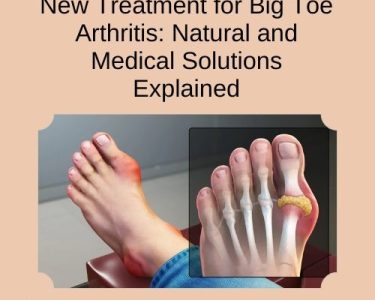Arthritis can affect any joint in the body, including the small joints of the feet. One of the most common yet often overlooked types is arthritis in top of foot, which can cause persistent pain, stiffness, and swelling that interferes with daily movement. The top of your foot is made up of several small bones and joints that play a key role in balance and motion, so inflammation here can make even walking or wearing shoes uncomfortable.
This article explores the early symptoms you shouldn’t ignore, and natural relief options for arthritis in top of foot, as well as how you can manage the condition effectively at home.
Understanding Arthritis in the Top of the Foot
The term arthritis refers to inflammation of one or more joints, leading to pain, swelling, and stiffness. When arthritis affects the top of the foot, it typically involves the midfoot joints, also known as the tarsometatarsal joints. These joints connect the bones of the midfoot (the cuneiforms and cuboid) with the long bones of the foot (the metatarsals). Arthritis on top of foot can develop slowly over time due to wear and tear, or it can result from previous injuries or underlying inflammatory diseases. Since the foot bears your body weight and absorbs impact during walking or running, it’s especially prone to stress-related joint issues. In such cases, using a Joint Support Herbal Supplement for Arthritis may help promote joint flexibility, reduce inflammation, and support overall foot health naturally.
Common Causes of Arthritis in the Top of Foot
Understanding the cause of your foot arthritis is key to finding an effective treatment for arthritis. Below are the most common conditions that lead to arthritis in top of foot:
1. Osteoarthritis (Wear and Tear Arthritis)
Osteoarthritis is the most common cause of arthritis on top of foot. It occurs when the cartilage that cushions your joints breaks down over time. As the cartilage wears away, the bones rub against each other, causing pain, stiffness, and swelling.
This type of arthritis often develops gradually, especially in people over 40, or those who’ve had repetitive stress on the feet from walking, standing, or running on hard surfaces.
2. Post-Traumatic Arthritis
If you’ve ever had a foot injury — such as a sprain, fracture, or dislocation — you may develop post-traumatic arthritis years later. The trauma damages the cartilage or alters the joint alignment, making it more susceptible to degeneration. Even a minor injury can accelerate arthritis in the top of foot if left untreated.
3. Rheumatoid Arthritis
Rheumatoid arthritis (RA) is an autoimmune disease in which the immune system attacks the body’s own joint tissues. It often affects multiple joints, including those in the feet. People with RA may experience symmetrical pain, meaning both feet are affected. RA can cause severe inflammation, deformities, and difficulty walking.
4. Gout
Gout is a form of inflammatory arthritis caused by the buildup of uric acid crystals in the joints. While it most commonly affects the big toe joint, it can also affect the midfoot or the top of the foot. Gout attacks cause sudden, intense pain, redness, and swelling.
5. Psoriatic Arthritis
This type of arthritis affects people with psoriasis (a chronic skin condition). Psoriatic arthritis can lead to pain and swelling on top of the foot and around the toes, along with changes in the toenails and skin.
6. Flat Feet or Abnormal Foot Mechanics
Improper alignment or flat feet can place extra pressure on the midfoot joints, leading to wear and tear over time. This mechanical stress can trigger arthritis on top of foot even in younger individuals.
Symptoms of Arthritis in Top of Foot
The symptoms of arthritis in top of foot can vary depending on the cause and severity, but common signs include:
- Pain and tenderness: Especially noticeable when walking, standing, or wearing tight shoes.
- Stiffness: Difficulty moving the foot or bending it up and down.
- Swelling: The top of the foot may appear swollen or puffy.
- Warmth or redness: Indicates inflammation in the affected joints.
- Bony bumps or spurs: Hard lumps on top of the foot may develop due to joint changes.
- Difficulty wearing shoes: Swelling or bone spurs make shoes feel tight or uncomfortable.
- Pain during rest: Some people feel throbbing or aching pain even at night.
If left untreated, arthritis on top of foot can worsen, leading to deformity, loss of mobility, and chronic pain.
How Is Arthritis in the Top of Foot Diagnosed?
Diagnosis usually begins with a physical examination by a doctor or podiatrist. They may:
- Check for swelling, warmth, or tenderness on top of the foot.
- Assess your foot’s range of motion.
- Ask about previous injuries or your medical history.
To confirm the diagnosis, doctors may use:
1. X-rays
X-rays show joint space narrowing, bone spurs, and other structural changes typical of arthritis.
2. MRI or CT Scan
These imaging tests help visualize soft tissues, cartilage, and bone damage more clearly.
3. Blood Tests
Used to detect markers of inflammation or autoimmune disorders like rheumatoid arthritis or gout.
4. Joint Fluid Analysis
If gout is suspected, a fluid sample from the affected joint can confirm uric acid crystal buildup.
Natural Relief Options for Arthritis in Top of Foot
While Natural Joint Supplement for Arthritis Joint Relief and medical treatments like anti-inflammatory drugs or steroid injections can help, many people prefer natural remedies for managing arthritis in top of foot. Here are some effective and evidence-based natural relief options:
1. Apply Cold and Heat Therapy
- Cold therapy reduces swelling and numbs pain. Apply an ice pack for 15–20 minutes, several times a day.
- Heat therapy relaxes muscles and increases blood flow. Use a warm compress or soak your feet in warm water for comfort.
2. Epsom Salt Foot Soak
Epsom salts contain magnesium sulfate, which may ease inflammation and relax muscles. Add 1–2 cups to a basin of warm water and soak your feet for 15 minutes.
3. Gentle Foot Exercises
Low-impact exercises can maintain joint flexibility and strengthen muscles around the joints. Examples include:
- Toe curls and extensions
- Ankle circles
- Rolling a tennis ball under the foot
- Stretching the Achilles tendon
Regular movement can prevent stiffness associated with arthritis on top of foot.
4. Anti-Inflammatory Diet
Your diet plays a big role in controlling inflammation. Try to include:
- Omega-3 fatty acids (from fish, walnuts, flaxseeds)
- Fruits and vegetables rich in antioxidants
- Whole grains like oats and quinoa
- Herbs and spices such as turmeric and ginger
Avoid processed foods, sugary drinks, and trans fats, as they can worsen inflammation.
5. Weight Management
Extra body weight adds stress to the joints, especially in your feet. Losing even a few pounds can significantly reduce pain and improve mobility.
6. Footwear Modifications
Choose shoes with:
- A wide toe box to avoid pressure
- Arch support to reduce strain
- Cushioned soles to absorb shock
Orthotic inserts or custom insoles can also help align the foot properly and relieve pain from arthritis in top of foot.
7. Herbal Remedies
Certain herbs and supplements may support joint health naturally:
- Turmeric (Curcumin): Has anti-inflammatory effects comparable to NSAIDs.
- Ginger: Reduces stiffness and pain.
- Boswellia Serrata: Helps improve joint flexibility.
- Omega-3 fish oil: Supports cartilage health.
Always consult your doctor before starting supplements, especially if you take other medications.
8. Massage Therapy
Foot massage improves circulation, reduces stiffness, and promotes relaxation. You can use coconut or olive oil for a gentle self-massage or seek professional therapy.
9. Physical Therapy
A physiotherapist can design a customized exercise plan to strengthen the muscles around your midfoot joints and improve balance.
10. Proper Rest and Foot Elevation
Resting your feet and elevating them above heart level can help reduce swelling and relieve pressure on inflamed joints.
Home Remedies for Arthritis on Top of Foot
In addition to the natural options above, several home remedies can bring added relief and help you Cure Your Arthritis Naturally:
- Apple Cider Vinegar (ACV):
Mix 1 tablespoon of ACV in a glass of warm water and drink daily to help reduce inflammation. You can also use it in a warm foot soak. - Castor Oil Massage:
Castor oil contains ricinoleic acid, known for its anti-inflammatory properties. Warm it slightly and massage gently on top of the foot before bedtime. - Turmeric Milk or Tea:
Consuming turmeric milk or turmeric tea daily can ease pain associated with arthritis in top of foot. - Ginger Compress:
Boil ginger slices in water, soak a cloth, and apply it as a warm compress to relieve soreness. - Eucalyptus Oil:
Its cooling effect reduces inflammation and pain. Mix a few drops with a carrier oil and massage the affected area.
When to See a Doctor
While natural remedies can help manage symptoms, it’s important to see a healthcare professional if you experience:
- Persistent pain or swelling lasting more than a few weeks
- Difficulty walking or standing
- Visible deformity or bone spurs
- Sudden, severe pain that may indicate gout or infection
Early diagnosis and treatment can prevent joint damage and improve your quality of life.
Medical Treatment Options
If natural remedies and lifestyle changes aren’t enough, doctors may recommend:
- NSAIDs (Nonsteroidal Anti-Inflammatory Drugs): To reduce pain and inflammation.
- Corticosteroid Injections: For temporary relief from severe inflammation.
- Orthotic devices: Custom inserts or braces for better support.
- Surgery: In advanced cases, joint fusion or replacement may be needed to relieve chronic pain.
Living with Arthritis in the Top of the Foot
Managing arthritis on top of foot requires a combination of self-care, medical support, and lifestyle adjustments. You can live an active and comfortable life by following these tips:
- Stay physically active with low-impact exercises like swimming or cycling.
- Maintain a healthy weight to reduce foot strain.
- Use supportive footwear designed for arthritis sufferers.
- Take breaks when standing or walking for long periods.
- Practice stress management techniques such as yoga or meditation.
Conclusion
Arthritis in top of foot is a painful yet manageable condition. Understanding its causes, recognizing early symptoms, and following a mix of medical and natural treatments can help you find lasting relief. From herbal remedies and anti-inflammatory diets to supportive footwear and gentle exercises, there are many ways to ease discomfort and regain mobility.
If your pain persists or worsens, consult a healthcare provider to explore further treatment options. With consistent care and attention, you can reduce inflammation, improve foot function, and maintain an active, healthy lifestyle despite arthritis.




